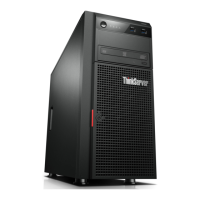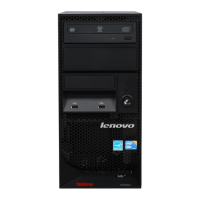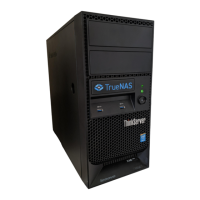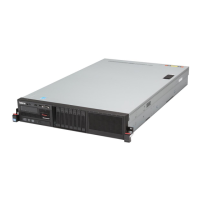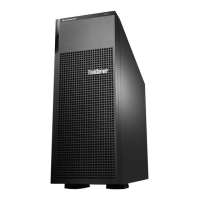Internaldrives
Internaldrivesaredevicesthatyourserverusestoreadandstoredata.Theinternaldrivessupported
byyourservervarybymodel.
•Harddiskdrive
–Fivetoeight3.5-inchhot-swapSerialAdvancedTechnologyAttachment(SATA)orSerialAttached
SCSI(SAS)harddiskdrives(SCSIistheacronymforSmallComputerSystemInterface)
–Uptoeight2.5-inchhot-swapSASharddiskdrives
–Uptofour3.5-inchhot-swapSATAorSASharddiskdrives
–Uptofour3.5-inchnon-hot-swapSATAharddiskdrives
Note:ForservermodelswithmorethanfourharddiskdrivesormodelsthatuseSASharddiskdrives,
theremustbeaRAIDcardinstalled.See“RAIDcard”onpage33
.
•Opticaldrive
–Uptotwo5.25-inchSATAopticaldrives(DVD-ROMorDVDBurner/CD-RWRambo8)
–Theserverhastwoopticaldrivebays.Theloweropticaldrivebayisinstalledwitha5.25-inchSATA
opticaldrive(DVD-ROMorDVDBurner/CD-RWRambo8).
–Iftheserverhasonlyoneopticaldriveinstalled,makesurethattheopticaldriveisinstalledin
thelowerbay(opticaldrivebay1).
–IftheserverhasonlyoneRemovableDiskTechnology(RDX)UniversalSerialBus(USB)drivebundle
(hereinafterreferredtoastheRDXUSBdrivebundle)installed,makesurethattheRDXUSBdrive
bundleisinstalledinthelowerbay(opticaldrivebay1).
–Theupperbayisforasecondaryopticaldriveonly.
Forthelocationinformationabouttheinternaldrivesordrivebays,see“Servercomponents”onpage25.For
informationabouttheRDXUSBdrivebundleandinstructionsonhowtoinstallit,refertothedocumentation
thatcomeswiththeRDXUSBdrivebundle.Inyourserver,theP6powerconnectorofthepowersupply
isfortheRDXUSBdrivebundle.YoucanpurchasethisoptionfromLenovo.TheoptionnameisLenovo
RemovableDiskTechnology(RDX)USBDriveBundle.TheRDXtechnologycombinestapebackupwith
diskstoragetohelpyouprotectandarchivedata.
Expansionslots
Theserverhasfourexpansionslotsonthesystemboard.Fordetailedinformation,see“Systemboard
components”onpage45.
Input/Output(I/O)features
•OneVideoGraphicsArray(VGA)DB-15connectorontherearpanel
•SixUSB2.0connectors(twoonthefrontpanelandfourontherearpanel)
•TwoRJ-45Ethernetconnectorsontherearpanel
•Twoserialconnectors(onefully-functionalserialconnectorontherearpanelandoneinternalserial
connectoronthesystemboardforoptionaluse)
Forthelocationinformationabouttheconnectors,refertotherelatedtopicsin“Locations”onpage13
.
Videosubsystem
AnintegratedgraphicscontrollerintheThinkServerManagementModule(TMM,alsoknownasthe
BaseboardManagementControllerorBMC)chiponthesystemboardtosupportaVGADB-15connector
ontherearpanelforconnectingvideodevices
Chapter3.Productoverview9

